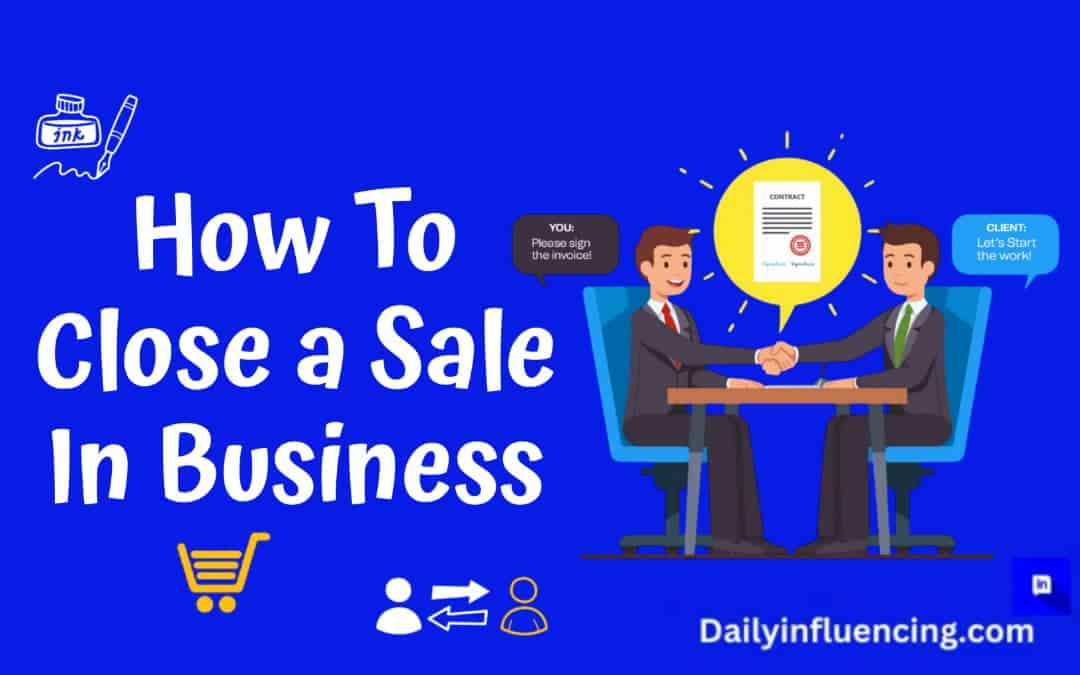
Close a sale in business is one of the most important skills any entrepreneur, salesperson, or business owner can master. Whether you’re selling a product, a service, or even an idea, knowing how to effectively close a sale can make the difference between success and failure. But what does it really mean to close a sale? And how can you do it in a way that feels natural, builds trust, and leaves your customer feeling satisfied?
In this article, we’ll break down everything you need to know about how to close a sale in business. We’ll explore the psychology behind closing a sale, share practical tips and strategies, and provide real-life examples to help you understand the process. By the end, you’ll have a clear roadmap for turning potential customers into loyal clients.
So, whether you’re a seasoned professional or just starting out, this guide will equip you with the tools you need to close a sale in business confidently and effectively. Let’s dive in!
What Does It Mean To Close a Sale?

Before we get into the nitty-gritty of how to close a sale in business, it’s important to understand what closing a sale actually means. At its core, closing a sale is the final step in the sales process where the customer agrees to make a purchase. It’s the moment when all your hard work—building rapport, understanding the customer’s needs, and presenting your solution—pays off.
However, closing a sale isn’t just about getting the customer to say “yes.” It’s about creating a positive experience that makes them feel confident in their decision. A successful close ensures that the customer is happy with their purchase and more likely to return in the future or recommend your business to others.
Think of it like this: closing a sale is like the final chapter of a book. It ties everything together and leaves the reader (or in this case, the customer) feeling satisfied. But to get to that final chapter, you need to lay the groundwork with a strong introduction, compelling content, and a clear call to action.
What Are The Ways To Close a Sale?

Now that we’ve covered the basics, let’s explore the key steps you need to take to close a sale in business successfully.
Step 1: Build Trust
The foundation of any successful sale is trust. If your customer doesn’t trust you, they’re unlikely to buy from you. Building trust starts from the very first interaction and continues throughout the entire sales process.
One of the best ways to build trust is by actively listening to your customer. Ask open-ended questions to understand their needs, challenges, and goals. Show genuine interest in their situation, and avoid being pushy or overly salesy. People can sense when you’re only interested in making a sale, and it can quickly turn them off.
Another way to build trust is by being transparent and honest. If your product or service isn’t the right fit for the customer, let them know. It might feel counterintuitive, but being upfront about limitations can actually strengthen your credibility and make the customer more likely to trust your recommendations in the future.
Finally, don’t underestimate the power of body language and tone of voice. A warm smile, confident posture, and friendly tone can go a long way in making the customer feel comfortable and at ease.
Step 2: Identify The Customer’s Needs
To close a sale in business, you need to understand exactly what the customer is looking for. This means digging deeper to uncover their pain points, desires, and motivations.
Start by asking questions like:
What challenges are you currently facing?
What are your goals for the next six months?
What’s most important to you when choosing a product or service?
As the customer shares their answers, take notes and look for patterns or recurring themes. This will help you tailor your pitch to address their specific needs and show them how your product or service can provide a solution.
Know that the goal isn’t to sell them something—it’s to help them solve a problem or achieve a goal. When you focus on the customer’s needs rather than your own agenda, closing the sale becomes much easier.
Step 3: Present Your Solution

Once you’ve identified the customer’s needs, it’s time to present your solution. This is where you highlight the features and benefits of your product or service and explain how it can address their specific challenges.
When presenting your solution, keep the following tips in mind:
Focus on benefits, not just features. For example, instead of saying, “This phone has a 12-megapixel camera,” say, “This phone’s high-quality camera lets you capture stunning photos of your family and friends.”
Use storytelling to make your pitch more engaging. Share examples of how other customers have benefited from your product or service.
Be concise and avoid overwhelming the customer with too much information. Stick to the most relevant points and let them ask questions if they want more details.
By presenting your solution in a clear and compelling way, you’ll make it easier for the customer to see the value in what you’re offering.
Step 4: Handle Objections
Even if you’ve done everything right, it’s common for customers to have objections or concerns before making a purchase. These objections might be related to price, quality, or whether the product is the right fit for their needs.
The key to handling objections is to listen carefully and respond with empathy. Avoid being defensive or dismissive, as this can make the customer feel unheard. Instead, acknowledge their concerns and provide thoughtful answers.
For example, if the customer says, “This is too expensive,” you might respond with, “I understand that price is a concern. Let me explain how this product can save you money in the long run by reducing maintenance costs.”
By addressing objections head-on, you’ll build trust and increase the likelihood of closing the sale.
Step 5: Ask For The Sale
This is the moment of truth—asking the customer to make a purchase. Many people struggle with this step because they’re afraid of coming across as pushy or aggressive. But if you’ve followed the previous steps and built a strong rapport with the customer, asking for the sale should feel natural.
There are several ways to ask for the sale, depending on the situation. Here are a few examples:
Based on what we’ve discussed, I believe this product is the perfect solution for you. Shall we go ahead and place the order?
I’m confident this service will help you achieve your goals. Would you like to get started today?
Many of our customers have seen great results with this product. Are you ready to give it a try?
If the customer hesitates, don’t be afraid to ask why. This can give you valuable insights into any remaining concerns and help you address them before closing the sale.
Step 6: Follow Up
Closing a sale in business doesn’t end when the customer makes a purchase. Following up is a crucial step in ensuring customer satisfaction and building long-term relationships.
Send a thank-you email or message to express your appreciation for their business. Check in a few days later to see how they’re enjoying the product or service and offer assistance if needed.
By following up, you’ll show the customer that you care about their experience and are committed to their success. This can lead to repeat business, positive reviews, and valuable referrals.
What Are The Things To Look Out For When Closing a Sale?
While learning how to close a sale in business, it’s just as important to know what not to do. Here are some common mistakes to avoid:
Being too pushy: No one likes feeling pressured into a decision. Be patient and give the customer time to think.
Talking too much: Sales is about listening, not talking. Make sure you’re giving the customer plenty of opportunities to share their thoughts and concerns.
Neglecting follow-up: Failing to follow up can make the customer feel undervalued and less likely to return.
By avoiding these mistakes, you’ll create a positive experience that encourages customers to come back again and again.
Examples Of Closing a Sale
To help you better understand how to close a sale in business, let’s look at a few real-life examples:
1. The Consultative Close
A software salesperson listens to a client’s challenges with project management and recommends a tool that streamlines their workflow. By focusing on the client’s needs and demonstrating the product’s value, the salesperson successfully closes the sale.
2. The Assumptive Close
A car salesman assumes the customer is ready to buy and says, “I’ll get the paperwork started for you.” This subtle approach can nudge the customer toward making a decision.
3. The Scarcity Close
An online retailer uses limited-time offers to create urgency, encouraging customers to make a purchase before the deal expires.
These examples show that there’s no one-size-fits-all approach to closing a sale. The key is to adapt your strategy based on the customer and the situation.
Conclusion
Close a sale in business is both an art and a science. It requires a combination of empathy, communication skills, and strategic thinking. By building trust, understanding the customer’s needs, presenting a compelling solution, and handling objections with care, you can increase your chances of success.
Furthermore, closing a sale isn’t just about making a one-time transaction—it’s about creating a positive experience that leads to long-term relationships. Whether you’re selling a physical product, a digital service, or even an idea, the principles of closing a sale remain the same.
So, the next time you’re faced with the challenge of closing a sale, take a deep breath, focus on the customer, and follow the steps outlined in this guide. With practice and persistence, you’ll become a master at closing sales and growing your business.
Now that you know how to close a sale in business, it’s time to put these strategies into action. Start by identifying your target audience, refining your pitch, and building strong relationships with your customers. Before you know it, you’ll be closing sales like a pro!
By following this guide, you’ll not only learn how to close a sale in business but also create meaningful connections with your customers. Happy selling!
Frequently Asked Questions
What is the simplest way to close a sale?
The simplest way to close a sale is to clearly show the decision-maker how they stand to benefit from your offering. Tell them exactly how you solve their problems and why you do it better than anyone else. You don’t need a complicated sales process.
What is the closing process of a sale?
What is sales closing? Sales closing, or getting a prospect to agree to a deal and sign a contract, is how reps make their quota and how businesses grow revenue. It represents the culmination of all your efforts. You put in the time and made a strong case for why your solution can alleviate the prospect’s pain points.
What Are The 7-step To sales process?
Prospecting.
Preparation.
Approach.
Presentation.
Handling objections.
Closing.
Follow-up.





